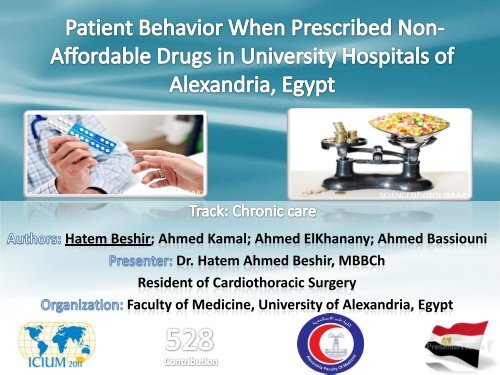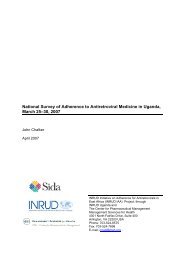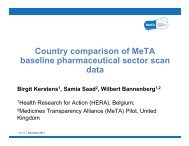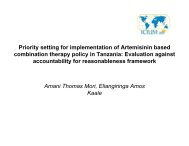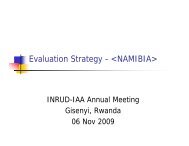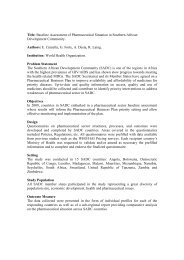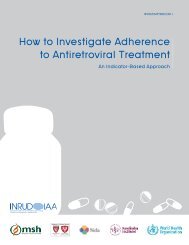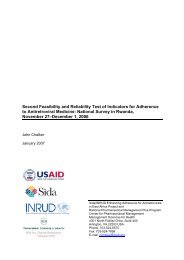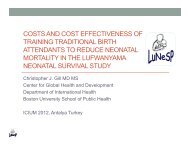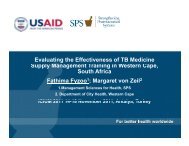Hatem Beshir; Ahmed Kamal; Ahmed ElKhanany; Ahmed ... - INRUD
Hatem Beshir; Ahmed Kamal; Ahmed ElKhanany; Ahmed ... - INRUD
Hatem Beshir; Ahmed Kamal; Ahmed ElKhanany; Ahmed ... - INRUD
Create successful ePaper yourself
Turn your PDF publications into a flip-book with our unique Google optimized e-Paper software.
<strong>Hatem</strong> <strong>Beshir</strong>; <strong>Ahmed</strong> <strong>Kamal</strong>; <strong>Ahmed</strong> <strong>ElKhanany</strong>; <strong>Ahmed</strong> Bassiouni<br />
Dr. <strong>Hatem</strong> <strong>Ahmed</strong> <strong>Beshir</strong>, MBBCh<br />
Resident of Cardiothoracic Surgery<br />
Faculty of Medicine, University of Alexandria, Egypt
1- Study Aims<br />
2- Problem Statement<br />
3- Methods<br />
4- Results<br />
5- Conclusions<br />
2
1<br />
1<br />
2<br />
3<br />
3<br />
4<br />
5<br />
To Identify cost-reducing strategies, including Cost<br />
related non adherence (CRN).<br />
To Understand how are these strategies employed by<br />
chronically-ill patients presenting to Alexandria<br />
University Hospitals.<br />
To Examine factors affecting prevalence of CRN.<br />
To Explore impact of better Doctor Patient Interaction<br />
(DPI) on CRN.<br />
To Pinpoint the best DPI methods that minimized CRN.<br />
3
1. Heisler M, Wagner TH, Piette JD. Clinician identification of chronically ill patients who have problems paying for prescription medications. Am J Med. 2004 Jun<br />
1;116(11):753-8<br />
2. Atella V, Schafheutle E, Noyce P, Hassell K. Affordability of medicines and patients' cost-reducing behaviour: empirical evidence based on SUR estimates from Italy<br />
and the UK. Appl Health Econ Health Policy. 2005;4(1):23-35.<br />
3. Wilson IB, Schoen C, Neuman P, Strollo MK, Rogers WH, Chang H, Safran DG. Physician-patient communication about prescription medication nonadherence: a 50-<br />
state study of America's seniors. J Gen Intern Med. 2007 Jan;22(1):6-12.<br />
4
4. World Health Organization Statistical Information System (WHOSIS) . World Health Statistics 2010. [Online]. 2010 Apr;(1):130-3. [cited 2010 Aug 18]. Available from:<br />
http://www.who.int/entity/whosis/whostat/EN_WHS10_Full.pdf<br />
5. Arab Republic of Egypt Central Agency for public mobilization and statistics health status report 2010. [Online].<br />
6. Tamblyn R, Laprise R, Hanley JA, Abrahamowicz M, Scott S, Mayo N, Hurley J, Grad R, Latimer E, Perreault R, McLeod P, Huang A, Larochelle P, Mallet L. Adverse events<br />
associated with prescription drug cost-sharing among poor and elderly persons. JAMA. 2001 Jan 24-31;285(4):421-9.<br />
5
6. Piette JD, Heisler M, Krein S, Kerr EA. The role of patient-physician trust in moderating medication nonadherence due to cost pressures.<br />
Arch Intern Med. 2005 Aug 8-22;165(15):1749-55. 6
Multivariate analysis using<br />
binary Logistic regression<br />
model revealed<br />
Income Ratio :Drug cost to<br />
monthly income ratio ,P=.003<br />
Education: (P=.028) (University 14.2%<br />
- High School 23.8% - Elementary<br />
26.7% - No Education certificate<br />
35.3%).<br />
Patients adopt multiple<br />
strategies in CRN to adopt with<br />
drug costs (given a score<br />
according to number of<br />
methods used).<br />
Insurance Coverage: (P
Cost Reducing Strategies Adopted by our sample<br />
Percent of Positives<br />
Seeking Alternative Medicine<br />
Ignoring presciption<br />
28.50%<br />
30.50%<br />
Postponing Purchase till payed<br />
55.40%<br />
Rationing<br />
33.40%<br />
Skip Doses<br />
Buy The most important drug<br />
Ask for Cheaper subtitute (Generic)<br />
Borrow money - Debt<br />
49.20%<br />
50.80%<br />
45.20%<br />
58.40%<br />
Axe Houshold Expenses or cut on other …<br />
81.50%<br />
9
Discussing Drug Costs With the<br />
Physician<br />
Never mentioned<br />
Yes, Mentioned In advance by the patient<br />
Yes, Mentioned in advance by the physician<br />
22%<br />
Patients Who Discussed Drug Costs<br />
With Physician against CRN<br />
Never Mentioned<br />
Yes, Mentioned in advance by the<br />
patient<br />
Yes, Mentioned in advance by the<br />
physician<br />
117<br />
49%<br />
73<br />
65<br />
29%<br />
30<br />
16<br />
2<br />
CRN -ve patients<br />
(n=48)<br />
CRN +ve patients<br />
(n=255)<br />
10
Doctor patient interaction methods to decrease CRN<br />
Mentioned the price of the Drug<br />
50%<br />
Reduced the numbers of medication prescribed<br />
30%<br />
Gave free sample medication of the prescribed<br />
Changed one to cheaper alternative<br />
42.90%<br />
42.70%<br />
Informed how & where to get less expensive …<br />
30%<br />
Mentioned which medications must not be …<br />
Asked if the patient can afford<br />
50%<br />
55%<br />
Showed sympathy about high drug costs<br />
78.00%<br />
11
Patients who did not discuss drug costs with physician<br />
Did not have enough trust in the physician<br />
20.30%<br />
Did not have enough time to mention it<br />
23.30%<br />
Did not think this issue important<br />
34.90%<br />
Thought that physician will not help<br />
47.10%<br />
Nobody asked<br />
71%<br />
Being embarrased to mention the problem<br />
75%<br />
12
Patient-physician<br />
communication can<br />
be an important<br />
determinant of selfmanagement<br />
behavior and<br />
health outcomes<br />
Clinicians can pay<br />
an important role<br />
with patients who<br />
face problems<br />
paying for<br />
prescription drugs<br />
Ensuring patient<br />
education on drug<br />
costs, showing<br />
strong emotional<br />
support and<br />
reducing poly<br />
pharmacy can<br />
significantly lower<br />
CRN<br />
Encouraging<br />
patients to ask for<br />
cheaper<br />
alternatives<br />
14


